Meteorites : A Voyage to the Asteroid Belt in Photos
Meteorites can be very beautiful and they can take on many different shapes and textures. There are dozens of different types of meteorites including stony, irons, and stony-irons such as pallasites. The majority of these meteorites originate from the main asteroid belt between Mars and Jupiter. An entire class of meteorites (the HED clan) have been tied to one of the largest asteroids in the solar system - 4 Vesta. The rarest meteorites are the planetaries which originate from the Moon and Mars.
In over 10 years of collecting and dealing meteorites, I have owned almost every type of meteorite. Whether they stay in my personal collection, are traded to another dealer, or sold to a collector, I make sure to document them all via photos. Now, for your viewing pleasure, sit back and enjoy an eye-candy ride to the asteroid belt - via the space rocks of the Galactic Stone & Ironworks collection.
All photos were taken by me with a Nikon digital camera. All specimens from Galactic Stone.
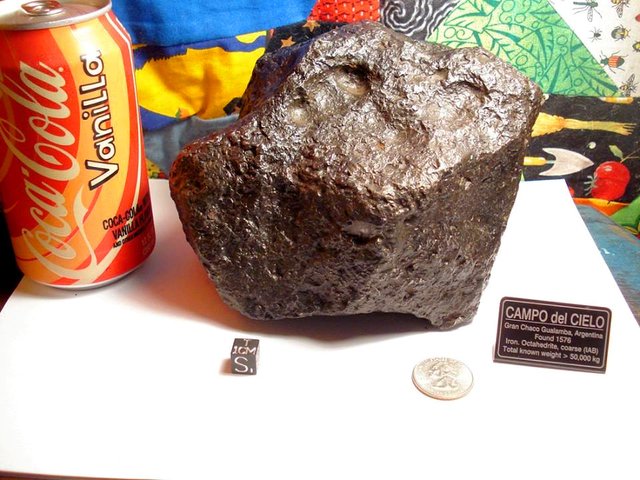
Photo : Campo del Cielo, iron meteorite (coarse octahedrite), Argentina. This type of meteorite is a tiny remnant of what was once the massive iron core of a differentiated asteroid.
...

Photo : NWA 4906 (North West Africa), Carbonaceous Chondrite CV3, polished slice, Morocco. Carbonaceous chondrites are a stony type of meteorite that contain a variety of ingredients. Typically found in carbonaceous chondrites : amino acids, aromatic hydrocarbons, volatile organics, water, nanodiamonds, calcium aluminum inclusions (CAI), interstellar grains, metal, and others. The round structures are chondrules : the basic building blocks of all chondrite meteorites.
...

Photo : Unclassified ordinary chondrite with fresh black fusion crust. Recovered from the Saharan Desert. This is the most common type of meteorite. These have a stony composition made up of various minerals, chondrules, metal inclusions, and clasts. Chondrites originated from asteroids in the main belt. These asteroids were destroyed in collisions with other space rocks. The fragmentary remnants of these parent asteroids fall to Earth as meteorites.
...
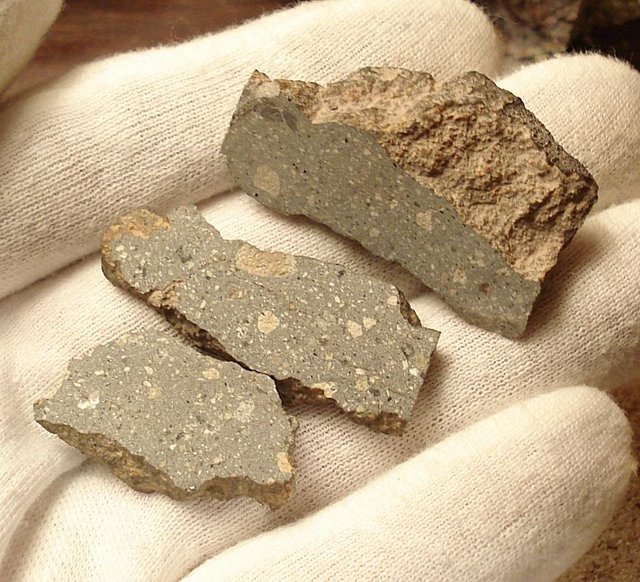
Photo : Freshly-cut Howardite (under classification currently), recovered from Morocco/Algeria border area. This is an achondrite of the Vestan clan. This meteorite originates from the asteroid 4 Vesta in the main belt. Vesta is the second largest asteroid in the solar system and is sometimes visible to the naked eye from Earth. Howardites, Eucrites, and Diogenites all come from Vesta and are collectively known as the HED or Vestan clan of meteorites. Howardites represent the "top soil" layer of regolith from Vesta. The composition is largely stony minerals that are pulverized and compacted tightly, along with xenoliths from the many foreign impactors that strike the Vestan surface.
...
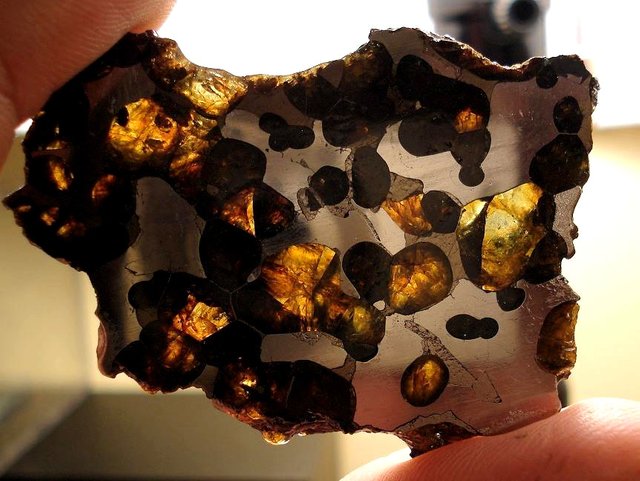
Photo : Brenham pallasite. Etched and polished slice. Recovered near Haviland Kansas. Pallasites represent the stony-iron mantle zone of a large asteroid. It consists of a nickel-iron matrix with scattered olivine (peridot) crystals. Pallasites are arguably the most beautiful of all meteorites, but they only appear this way on the inside after cutting and polishing. From the outside, an uncut pallasite is unremarkable and looks like a bumpy rock.

Photo : Lunar meteorite NWA 10203 (feldspathic breccia). Uncut small fragment. Recovered from Morocco. This is a bonafide "Moon Rock" - a piece of the Moon. Lunar meteorites are the result of large asteroid collisions with the Moon's surface. These impacts throw lunar material up from the surface into space. These fragments then cross Earth's orbit and fall to Earth as meteorites. It has a stony composition consisting of regolith, clasts of minerals such as anorthosite, and xenoliths from foreign impactors.
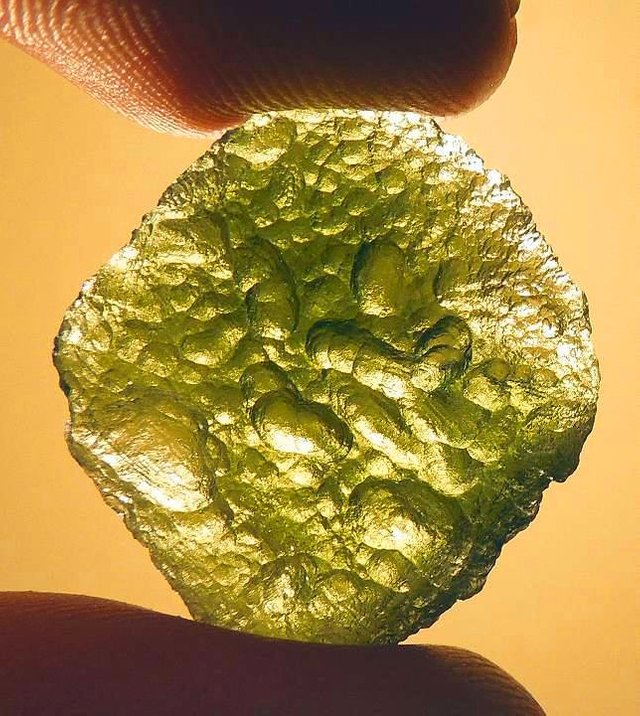
Photo : Moldavite impact glass. Czech Republic. Moldavite is not a meteorite. It is the result of a massive meteorite impact in the distant past in what is now central Europe. The impact vaporized the bedrock of the target zone and the cataclysmic forces fused some of the rock with remnants from the meteorite. After consolidation and cooling, the result is the beautiful green glassy material that is highly prized amongst collectors and jewelry-makers. It is truly a cosmic gemstone.
...
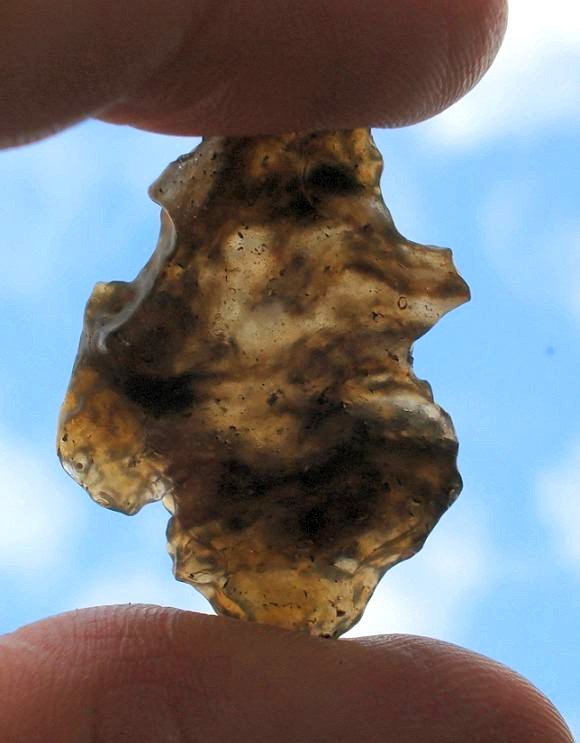
Photo : Libyan Desert Glass. Recovered from the Great Sand Sea near the Egyptian-Libyan border. Like Moldavite, Libyan Desert Glass is an impact glass, and not a meteorite. It was formed in the same manner as Moldavite during a massive meteorite impact. Libyan Desert Glass was used in jewelry by the Pharaohs of ancient Egypt.
That is all for now. I hope you enjoyed this little slideshow of cosmic gems. :)